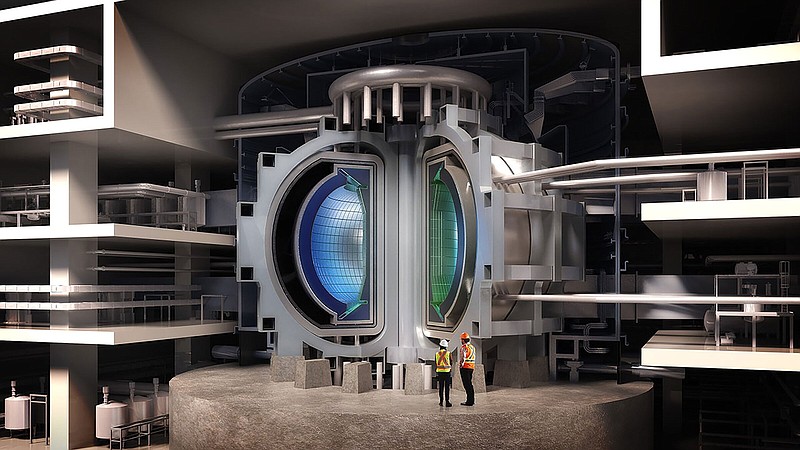SAN DIEGO -- Global interest, research and investment in nuclear fusion is at an all-time high, and San Diego-based General Atomics has announced a program to design, build and operate a pilot plant aimed at taking a crucial step toward making the long sought-after potential of nuclear fusion a reality.
General Atomics has worked on fusion projects for decades and by leveraging the know-how and proprietary technologies the company has developed over the years, the pilot will develop a prototype that produces net electricity gain -- meaning its output will exceed its input -- that promises to eventually become a full-scale power plant, according to the company.
"This is really the next step, moving out of the research and development phase of fusion science and putting that knowledge and experience" onto a path to commercial use, said Brian Grierson, director of the Fusion Pilot Plant Hub at General Atomics.
Nuclear fusion differs from fission, which is the process used in commercial nuclear power plants. Fission splits the nuclei of atoms to create power, while fusion causes hydrogen nuclei to collide and fuse into helium atoms that release incredible amounts of energy -- essentially replicating the power of the sun.
Fusion technology was critical in the development of the hydrogen bomb in the 1950s, but a peaceful, commercial application for fusion as an inexhaustible energy source has intrigued scientists ever since.
To fuse hydrogen atoms on earth, they need to be heated to temperatures in the millions of degrees in order to collide and produce a hot gas called plasma.
Nuclear fusion emits no greenhouse gases, leaves behind no long-lived nuclear waste and should a disturbance occur during the fusion process, the plasma cools within seconds and the reaction stops, thereby preventing the risk of a meltdown or accident like the one at Fukushima, experts say.
"In terms of the long-term prospects for large scale energy production, I think fusion remains the perfect energy source," Grierson said.
THE PILOT PLANT
The first phase of the General Atomics pilot project will center on developing the technologies needed to make the fusion pilot work and then firming up its design.
In the second phase, project officials will concentrate on developing the plant itself, including where -- determining where to build it and when to break ground.
Upon completion, the plant will be one that "uses real fuel and produces real electricity with generators," Grierson said. As for when the plant will start operating, no specific date has been announced but Wayne Solomon, vice president for Magnetic Fusion Energy at General Atomics, said the company is looking at the mid-2030s.
Solomon said it will probably not be at the company's headquarters near La Jolla or on its Poway campus. Theoretically, the pilot plant could be built anywhere in the country but, Solomon said "all of our folks working here would love to see it being built in Southern California," if costs and regulations prove to be amenable.
General Atomics officials estimate the plant's footprint would resemble that of a conventional electricity-generating station. "It is something certainly much smaller than a large solar farm or a wind farm or anything like that," Grierson said.
The plant is expected to produce a minimum 50 megawatts of electricity.
"We have a sufficient understanding that we can go through this design activity and come up with a facility that looks quite attractive and that can produce net electricity," Solomon said.
"Net electricity" is the crucial term because the key to making fusion practical is to make sure the amount of power going into the plant is exceeded by the amount that's produced. Over the years, fusion power has been generated only for very short periods in laboratory settings.
No price tag has been attached to the pilot plant yet. Solomon said General Atomics has "the resources that we need to execute on our early milestones" and envisions forming partnerships with government and industry to fully fund and complete the project as it moves toward construction.
FEDERAL INTEREST
The federal government has indicated it's getting serious about nuclear fusion.
The recently enacted legislation dubbed the Inflation Reduction Act has earmarked $280 million for nuclear fusion projects. The law also provides billions to the Department of Energy's loan program office, some of which could go to fusion proposals.
And in September, the Nuclear Regulatory Commission released a white paper that outlined a licensing and regulatory framework for the fledgling fusion industry by the end of 2027.
General Atomics has a long history with nuclear fusion research and development.
The company is a key contributor to ITER, a massive, multinational fusion facility under construction in France that is designed to show whether fusion technology can be commercially viable.
General Atomics is fabricating and shipping the modules that make up the world's most powerful magnet -- called a Central Solenoid -- that will be inserted into the heart of the ITER facility.
General Atomics also operates the DIII-D National Fusion Facility, on the behalf of the U.S. Department of Energy.
The facility features a magnetic chamber called a tokamak -- a doughnut-shaped metal vacuum chamber surrounded by incredibly potent magnets. Fuel consisting of hydrogen isotopes can be converted into plasma by heating the fuel to more than 180 million degrees Fahrenheit.
